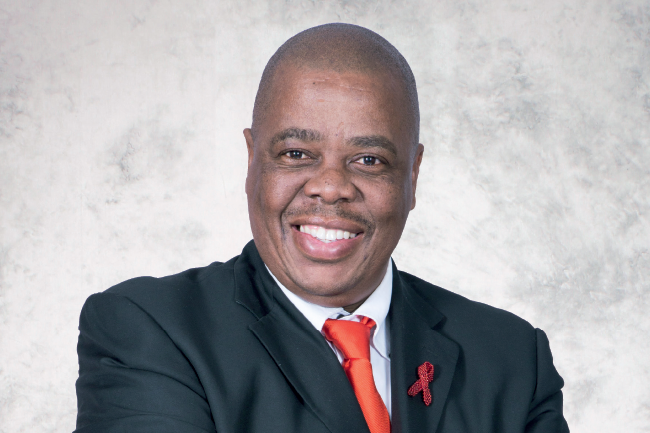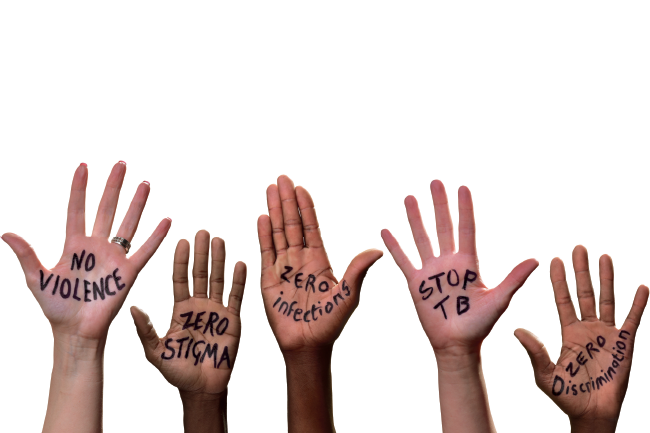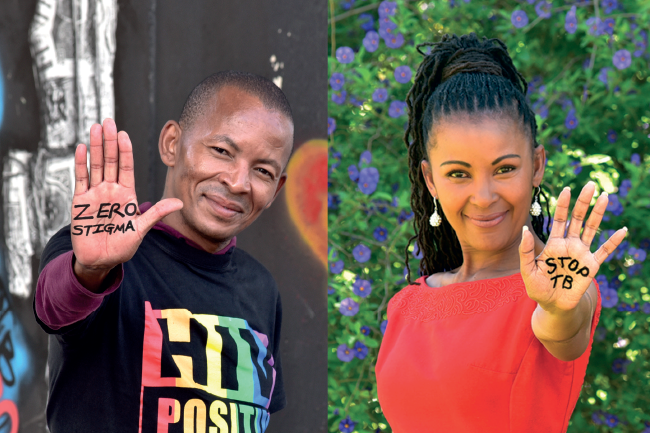When Deputy President David Mabuza addressed the crowd attending the 31st World Aids Day Commemoration at James Motlatsi Stadium in South Africa’s North West province, on 1 December 2019, he stressed the importance of aiming for ‘zero’ – zero HIV/Aids infections; zero discrimination; and zero Aids-related deaths.
Mabuza, who as chairman of the South African National Aids Council (SANAC), was echoing and amplifying the heartfelt sentiments of medical practitioner and CEO of SANAC, Dr Sandile Buthelezi, who since achieving medical and management degrees has in many capacities, dedicated himself to not just the fight against the HIV/Aids epidemic, but that of TB and sexually transmitted infections (STIs).
Buthelezi has himself experienced the tragic loss of friends and family to Aids-related illnesses, so there is much weight behind his emphasising that, with 7.4 million infections of HIV in South Africa, the fight is not moving as fast as we want.
‘When you know how much work is being done and the investment in resources made in support, the return on investment is still slow. That return is measured in lives, and we’re just not saving enough lives as quickly as we want,’ he says. ‘While we are somewhat pleased that there has been a 40% reduction in the number of new infections since 2010, with 2016 to 2018 showing a decrease from 270 000 to 222 000, it remains that in terms of global figures, 21% of those living with HIV across the world are South African residents.
‘In today’s age no one should die of HIV/Aids or TB-related illnesses. These are preventable diseases and, in terms of TB, even curable.’
There is some comfort to be had in that 5 million HIV-infected people are on treatment, a figure that has largely been achieved through SANAC’s activities, which bring together government, civil society and the private sector in a collective response to the challenges of HIV, TB and STIs. It does this through many campaigns and activities, among them the fostering and maintaining of dialogue, guiding strategies and policies, the mobilisation and supply of resources, motivating partnerships locally and internationally, and the monitoring and evaluation of research.
‘What is key to our achieving objectives is reaching communities, especially those in rural environments,’ says Buthelezi. ‘While SANAC may carry government’s message and contributes 80% of all resources, we are dependent on civil society and the private sector to further assist us in passing on the crucial message of prevention, of the need to be tested, to go on treatment and thereafter to maintain such treatments.

‘This is a comprehensive message and one that mirrors that of the UNAids narrative, which says that by 2020, “90% of people living with HIV will know their HIV status; 90% of all people diagnosed with HIV infection will receive sustained antiretroviral therapy; and 90% of all people receiving antiretroviral therapy will have viral suppression”.’
South Africa achieved its 90-90-90 objectives in June 2018, in Eshowe, Zululand (which is in the country’s KwaZulu-Natal province) a year ahead of the goal, with results of 90% of people living with HIV knowing their status; 94% of those on antiretroviral treatment; and 95% having a suppressed viral load. These figures are confirmed by Doctors Without Borders, which along with South Africa’s Department of Health implemented a community-based model project that is being rolled out by SANAC across the country.
The project has special significance for Buthelezi, who was born in Eshowe, the oldest town in Zululand. ‘The project was all-encompassing, involving traditional and local health workers visiting homes and community venues to inform and disburse knowledge about HIV. They diagnosed, distributed and monitored treatment,’ he says. ‘Eshowe proved that when a community takes ownership of their HIV programmes, the drive towards “zero” can be manifested much quicker than other models, although we do hail all efforts that promote dialogue around the pandemic.’
These are conversations that Buthelezi says must become fashionable. ‘By that I mean the more we talk about it, the less stigma prevails. Despite all the knowledge out there, there are still pockets of discrimination. SANAC, along with the Human Research Council, in 2014 worked with different groups of HIV sufferers to examine the stigmas, and the stories were horrifying. There has been improvement since, but again this boils down to understanding the disease and being part of a community that supports sufferers.’

Buthelezi says, however, that communities are not islands. They need the input of civil society and the private sector to achieve faster and more effective results.
‘The mining sector is notable and has had considerable success in being one of the first industries to introduce treatment and education campaigns, but they now need to take this beyond their workforce into their local communities. That said, corporates can learn a great deal from the mining industry on how to implement similar programmes.’
Buthelezi discloses that the retail sector is lagging somewhat, as is the transport sector whose drivers are vulnerable to the commercial, largely female, sex workers along the major arterial routes: ‘a major contributor to the spread of epidemics across the country’, he says.
Women are, in fact, the highest HIV-infected demographic. ‘In 2018, we determined that 62% of all HIV infections are women, but the worry is that more men are dying because men tend not to go on antiretrovirals, or when they do, they don’t sustain the treatments.’
This applies equally to TB and STIs. ‘In 2018, the World Health Organisation announced that annually South Africa recorded 500 new TB infections per 100 000 people. We still consider this high but it is a decrease on previous years, and we’re optimistic that the soon-to-be-released 2019 figures from the recently concluded, first-ever TB prevalence [study] will show further declines.
‘The STI stats are far more concerning. We’re registering more than 1 million cases a year,’ says Buthelezi. ‘It’s worrying because people are still not using condoms; they aren’t screening themselves; and they ignore symptoms. Women often only discover they have an STI when undergoing a PAP smear.
‘Women are the most vulnerable because of general attitudes in communities that show a gender imbalance, which prevails across all aspect of local life. We are working hard to change the mindset of men and society, to infuse into the psyche of the boy-child that they are not superior to women; that women are their equals.’

It’s an important message because, as Buthelezi points out, although abuse is a criminal action, the anti-crime enforcement agencies are under severe pressure and strain. ‘They cannot drive this on their own, which is why SANAC also speaks out against women and child abuse, and promotes women being appointed into positions of authority,’ he says. This was actually one of the key messages delivered by Mabuza on World Aids Day. The theme, Communities Make the Difference – Cheka Impilo, drove the point, says Buthelezi, ‘that no one should be left behind’.
Mabuza emphasised that human rights must be enjoyed by all, irrespective of gender or sexual orientation and with as much vigour as is given to end the HIV/Aids epidemic. SANAC has addressed gender-based violence through its Men Championing Change programmes. One such, Takuwani Riime, is considered of one of the most robust men-mobilisation initiatives in the country, addressing as it does the social ills perpetuated by patriarchy.
‘A platform like World Aids Day has a great purpose – it is a way for us to report back to the world and our communities on how we are progressing in the fight to end HIV/Aids as a public health threat. We can celebrate our victories, inform on the challenges, revisit the goals and, most importantly, reinforce our collective message,’ says Buthelezi. ‘However, we don’t want this day to be viewed as only an annual gesture in the acknowledgment of the pandemic.
‘Every day, thousands of people are at work in the HIV/Aids, TB and ST| field. We need the media to have a bigger appetite for their (and SANAC’s) news. What destroys organisations like SANAC and those that work for them, is not keeping the public informed enough about what we do and how society can help.
‘This is why SANAC communicates at every opportunity. [Daily], we are on social media platforms, and we try to get to as many community events as possible. We talk to people, which is something I personally encourage in my team,’ says Buthelezi. ‘You can’t expect people to do this job without leading them by example. All South Africans are jointly accountable, be that in the spread of the epidemics or the dissemination of knowledge. ‘People must take responsibility for their lives, and those with whom they come into contact.
‘Everyone has a responsibility to prevent infections. Bear in mind that there are some 50 million South Africans who are HIV-negative. We must collectively work together to ensure that, at least, it stays that way, and that we remain focused on the “zero” targets.’


